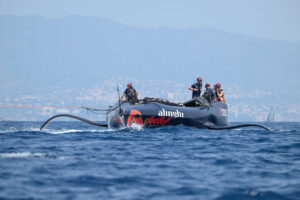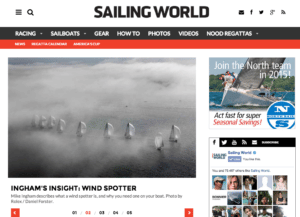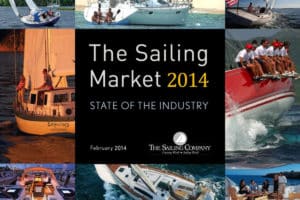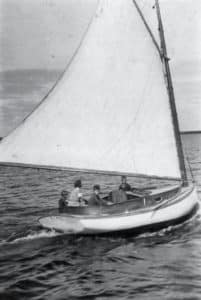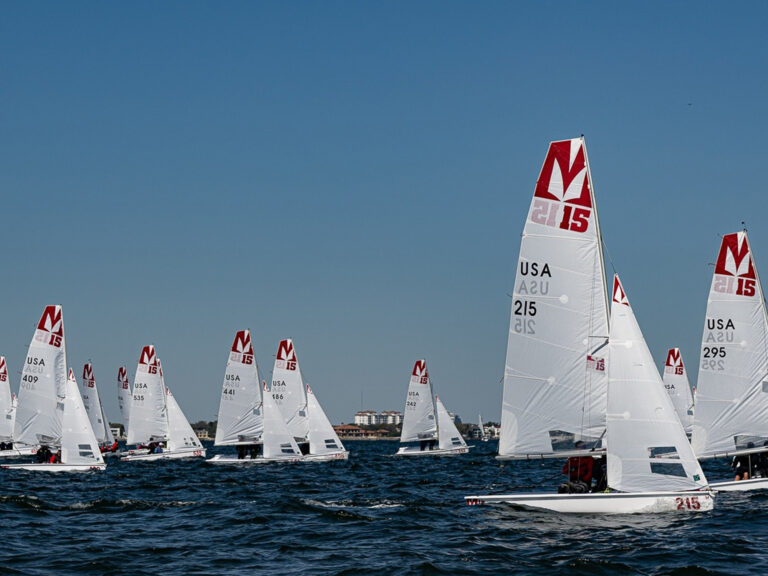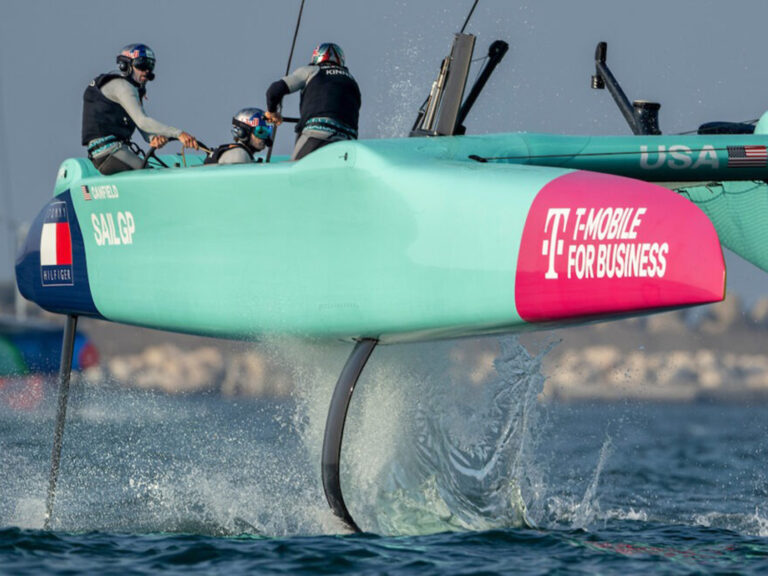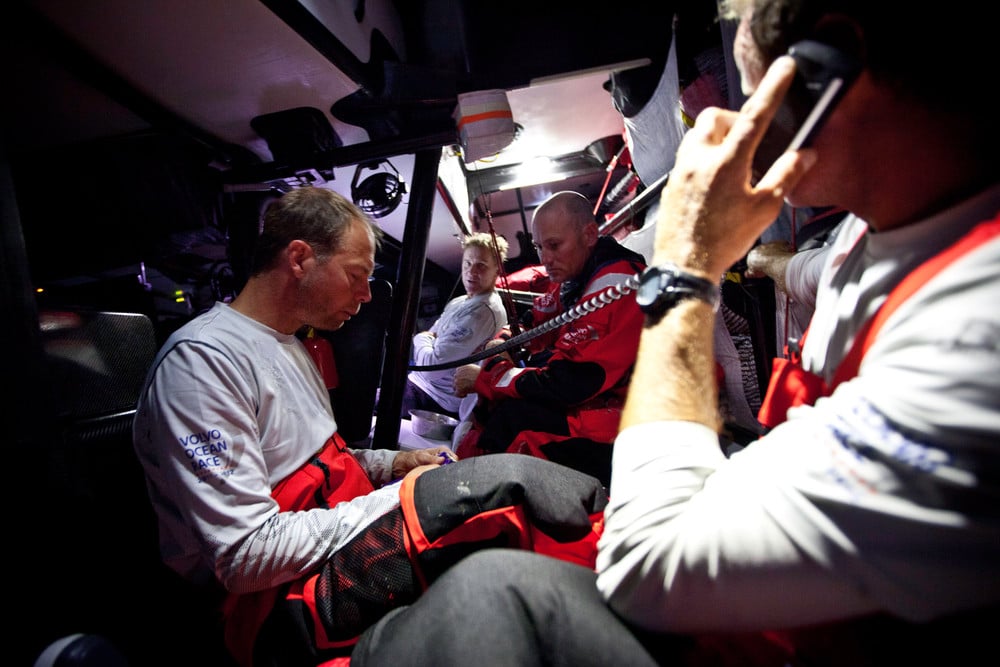
120321_VOR_Ross
Ryan O’Grady, a veteran follower of the Volvo Ocean Race and a top amateur sailor, is providing regular insight and analysis on the 2011-’12 Volvo Ocean Race for SailingWorld.com. To get the full picture of this dynamic race, follow the racing in our Finish Line forum, track the fleet, and catch up on the race with O’Grady’s previous Volvo Voyeur blogs.
**Before leaving the dock to start Leg 5 of the Volvo Ocean Race, Camper MCM Hamish Hooper offered a pretty straightforward view of what the fleet could expect on their way to the Southern Ocean and Cape Horn. “The forecast looks particularly heinous with up to 40 knots plus on the nose for a fair chunk of the next 24 hours.’’ **
Little did Hooper know, his predictions were optimistic. “The boat has been taking a pounding since the start,” Camper skipper Chris Nicholson said in a radio interview after the start. “We saw a little bit of 45 knots last night. It was quite dark so I imagine it was about a three metre sea state, but it was quite confused so we weren’t ever really able to land the boat softly at all.” Onboard Abu Dhabi Ocean Racing, according to MCM Nick Dana, things weren’t much better. “What a thrashing we took last night. It was all happening: people being sick in the bilge, water logged sails being dragged across lifeless off-watch bodies floating in the bilge, even 14-hour straight runs with no sleep for some of the boys. It was an absolute challenge to do anything.”
Conditions took their toll early when Abu Dhabi Ocean racing’s Azzam damaged the internal support bulkhead for the J4 headsail just 40 miles from the start. The J4 is a heavy weather headsail that is tacked about a meter behind the forestay. The failed bulkhead supports the 10 tons of luff tension required fly this workhouse sail. Wisely, skipper Ian Walker and crew bit the bullet and returned to Auckland to have the shore team re-bond the bulkhead into place. Within 24 hours, Azzam and crew were back in the water, but were forced to heave to as a tropical depression ravaged the greater Auckland area.
“We need to exit the Colville Channel where the winds notoriously funnel along the Coromandel Range but the weather stations are reporting 50-knot average winds and gusts in the low 60s,” Walker reported from the boat. “Right now we are trapped in the windy section of the tropical low with storm force winds between us and the lighter winds to the east. We have decided to hold for a few hours in the lee of the islands of the Hauraki Gulf and monitor the weather stations as this tropical low is a very active and fast changing phenomenon. We are stuck in a real dilemma—do we take on the storm-force winds when we have little to gain by doing so, or do we hold on and wait for the winds to abate thereby losing more miles and time to our competitors? To set off when we are already a day behind the fleet and put ourselves out of the race would be foolish and yet to hove to and wait is the most frustrating thing on earth.” The damage and delays have cost Walker and crew over 400 miles. If Azzam is as fast downwind as the Farr design office keeps saying she is, maybe there is a chance for her to catch up and get back in the race.
Meanwhile, at the front of the fleet, PUMA Ocean Racing is now a hospital ship, as the conditions have taken down two crewmembers in the last 24 hours. Bowman Casey Smith injured his lower back moving the sail stack and newcomer helmsman Thomas Johanson—replacing Kelvin Harrap, who is sitting this leg out due to injury—dislocated his right shoulder. According to PUMA skipper Ken Read, “Thomas was hit by a large, unexpected wave when going on watch and slid through the cockpit, hitting his shoulder and upper lip on the leeward side of the cockpit. He had a helmet on at the time, which was lucky. Jono Swain did a great job getting advice then popping Thomas’ shoulder back in. Immediately he was in no pain and is recovering quickly.” PUMA MCM had the video camera rolling as Thomas’ shoulder was reset, and you can see it here.
“At one point we were heading to the Chatham Islands to get rid of both of them,’’ Read said. “But then Thomas’ shoulder got popped back in and we had a long talk to Casey. He’s a tough guy, he’s a team guy, so essentially we said, let’s at least get to Cape Horn and if there’s no improvement by then, we’ll figure out a way to get rid of him. But up until then there’s not a whole lot of options.” Sailing a Volvo 70 isn’t easy with a full crew in calm weather. Being understaffed with the first major Southern Ocean low looming, PUMA will be faced with it’s biggest test of character yet as they attempt to keep up with the leaders and keep Smith, who is very much in pain, comfortable for the next few thousand miles.
As ferocious as the weather has been offshore, some of the biggest storm clouds to face the fleet appeared even before everyone left the dock. The failure of Camper to win a leg has generated public outcry in some New Zealand circles. In fact, the big red boat has now been nicknamed “Clifford” in some Volvo circles. You know, as in Clifford, the Big Red Dog. None other than team boss Grant Dalton is leading the chorus of frustration over Camper’s performance. Dalts has lashed out at the decisions of the afterguard, and even flew to Sanya with coach Rod Davis to attempt to fix some of the decision- making issues, after Camper executives convinced Dalton not to fire team skipper Chris Nicholson and navigator Will Oxley.
Now, Dalton has publicly ripped the designer of Camper, Marcelino Botin. In an article published in Sunday’s Star-Times newspaper, Dalton states “Yeah, I lay that performance deficit in certain angles 100 percent at the feet of the designer. No doubt of that. I take it pretty personally if we are not winning. I can only put my faith in the fact that we are four out of nine legs and things could change. But there is absolutely no doubt that at certain angles we are slow relatively to these other three ‘Juan K’ boats.” Dalton goes even further, saying “I just guess we aren’t going to be building any boats together again.” With less than half of the race completed, it remains to be seen what Dalton hopes to accomplish by making these comments public. This outburst isn’t likely to motivate Botin Partners to assist in any performance optimizations of the boat from here on out. Considering the crew can’t be touched for now, the blame must go somewhere, but if Camper doesn’t perform well in the expected strong downwind conditions ahead, not even Camper’s executives may be able to save Nicholson from a sacking in Brazil.
Camper wasn’t the only team to see a storm brewing in Auckland. On the 15th, the French newspaper Le Figaro reported “The mutual insurer Groupama intends disengagement of sports sponsorship in sailing and football (Lyon and Marseille), under the economic plan he has committed to improve its financial situation, said today its chief executive Thierry Martel. Present since 1997 alongside Franck Cammas, Groupama intends to retire after the end of the Volvo Ocean Race.”
Groupama’s withdrawal of sponsorship comes on the heels of the French environmental company Veolia, which pulled out of Roland Jourdain’s MOD 70 campaign, and Banque Populaire ending it’s support of the Jules Verne winning catamaran Banque Populaire V. Economic turmoil in Europe has already battered the hopes of many would-be Volvo teams. Now, with that turmoil affecting even the largest French Ocean stars, the entire sport of ocean racing is in jeopardy. No part of our sport relies more on corporate funding than ocean racing, and French corporate support makes events like the Vendée Globe, Figaro, and TJV go around. If France’s biggest sailing stars, which are household names, can’t retain sponsorship, how will emerging teams be able to garner support for events like the Volvo? Already Spain has been unable to fulfill their commitment to have 2 boats in this race. Groupama’s sponsorship with Franck Cammas was due to last until 2015 and include the next edition of the Volvo, but that is now clearly in jeopardy. Cammas’ team has proven to shoulder adversity well, including bow damage at the end of legs 2 and 4 which saw thousands of gallons of water enter the boat, but can they keep their heads above the financial turmoil that threatens to derail the program? Currently, the answer is yes, as Groupama, PUMA, and Telefonica are neck and neck on their race to Cape Horn.
To win the Volvo Ocean Race, teams have to battle the elements, challenging corporate pressures, and the personality conflicts that arise after months at sea. How will the teams respond to these challenges in Leg 5? Stay tuned to find out.

